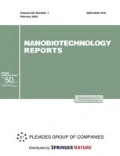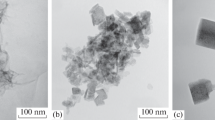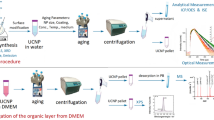Abstract
We have studied the acid-base, adsorption, and electrokinetic properties of 2D nanostructures—agglomerates of pseudoboehmite (AlOOH) nanosheets 2–5 nm in thickness—that were synthesized from electro-explosive Al/AlN nanopowder. By the example of adsorption of anionic dye eosin and cationic dye methylene blue, it is found that the synthesized nanostructures have pronounced anion-exchange properties. It is shown that agglomerates of AlOOH nanosheets exhibit properties of a weak base when they are added to the biological model solutions (cell-culture medium and sodium phosphate buffer) and deionized water; in this case, an increase in pH in the media takes place both due to the release of the OH groups and the ionexchange adsorption. The possible impact of the synthesized AlOOH 2D nanostructures on the suppression of tumor-cell proliferation is considered via changes in the parameters (acidity and ionic composition) of their microenvironment.
Similar content being viewed by others
References
G. Mikhaylov, D. Klimpel, N. Schaschke, U. Mikac, M. Vizovisek, M. Fonovic, V. Turk, B. Turk, and O. Vasiljeva, “Selective targeting of tumor and stromal cells by a nanocarrier system displaying lipidated cathepsin B inhibitor,” Angew. Chem. 53, 10077–10081 (2014).
H. Lee, D. Sung, J. Kim, B. T. Kim, T. Wang, S. S. A. An, S. W. Seo, and D. K. Yi, “Silica nanoparticle-based dual imaging colloidal hybrids: cancer cell imaging and biodistribution,” Int. J. Nanomed. 10, 215–225 (2015).
V. A. Oleinikov, A. V. Sukhanova, and I. R. Nabiev, “Fluorescent semiconductor nanocrystals in biology and medicine,” Ross. Nanotekhnol. 2 (1–2), 160–173 (2007).
J. A. Burger, P. Ghia, A. Rosenwald, and F. Caligaris-Cappio, “The microenvironment in mature B-cell malignancies: a target for new treatment strategies,” Blood 114, 3367–3375 (2009).
J. A. Burger, “Targeting the microenvironment in chronic lymphocytic leukemia is changing the therapeutic landscape,” Curr. Opin. Occol. 24, 643–649 (2012).
V. A. Chubenko, “Promising treatments for malignant neoplasms,” Prakt. Onkol. 8 (4), 228–234 (2007).
F. Danhier, O. Feron, and V. Preat, “To exploit the tumor microenvironment: passive and active tumor targeting of nanocarriers for anti-cancer drug delivery,” J. Controlled Release 148, 135–146 (2010).
N. Puvvada, S. Rajput, B. N. P. Kumar, S. Sarkar, S. Konar, K. R. Brunt, R. R. Rao, A. Mazumdar, S. K. Das, R. Basu, P. B. Fisher, M. Mandal, and A. Pathak, “Novel ZnO hollow-nanocarriers containing paclitaxel targeting folate-receptors in a malignant pH-microenvironment for effective monitoring and promoting breast tumor regression,” Sci. Rep. 5, 11760 (2015).
I. F. Robey, B. K. Baggett, N. D. Kirkpatrick, D. J. Roe, J. Dosescu, B. F. Sloane, A. I. Hashim, D.L. Morse, N. Raghunand, R. A. Gatenby, and R. J. Gillies, “Bicarbonate increases tumor pH and inhibits spontaneous metastases,” Cancer Res. 69, 2260–2268 (2009).
D. M. Prescott, H. C. Charles, J. M. Poulson, R. L. Page, D. E. Thrall, Z. Vujaskovic, and M. W. Dewhirst, “The relationship between intracellular and extracellular pH in spontaneous canine tumors,” Clin. Cancer Res. 6, 2501–2505 (2000).
R. A. Cardone, V. Casavola, and S. J. Reshkin, “The role of disturbed pH dynamics and the Na+/H+ exchanger in metastasis,” Nature Rev. Cancer 5, 786–795 (2005).
T. Ya. Datsko and V. I. Zelentsov, “The dependence of the surface charge of the gamma-aluminium oxide and fluorine adsorption on the solution temperature,” Surf. Eng. Appl. Electrochem. 45, 404 (2009).
Physical and Chemical Aspects of Adsorbents and Catalysts, Ed. by B. G. Linsen (Academic, London, 1970; Mir, Moscow, 1973).
M. I. Lerner, N. V. Svarovskaya, S. G. Psakh’e, and O. V. Bakina, “Production technology, characteristics, and some applicationsof electric-explosion nanopowders of metals,” Nanotechnol. Russ. 4, 741 (2009).
L. K. Gerunova, “Method of aluminium determination in biological objects,” RF Patent No. 2265842, Byull. Izobret. No. 34 (2005).
The Theory and Practice of pH Metric Definition of Acid-Base Properties of the Solid Surface, The School-Book, Ed. by K. V. Ikonnikova, L. F. Ikonnikova, T. S. Minakova, and Yu. S. Sarkisov (Tomsk. Politekh. Univ., Tomsk, 2011) [in Russian].
The Fluorides and Oxides of Alkaline Earth Metals and Magnesium. The Surface Properties, Ed. by T. S. Minakova and I. A. Ekimova (Tomsk. Gos. Univ., Tomsk, 2014) [in Russian].
G. G. Savel’ev, T. A. Yurmazova, A. I. Galanov, S. V. Sizov, N. B. Danilenko, M. I. Lerner, F. Teper, and L. Kaledin, “Adsorption capacity of nanosized fiber aluminium oxide,” Izv. Tomsk. Politekh. Univ. 307, 102–107 (2004).
A. Wittayanukulluk, D. P. Jiang, F. E. Regnier, and S. L. Hem, “Effect of microenvironment pH of aluminum hydroxide adjuvant on the chemical stability of adsorbed antigen,” Vaccine 22, 1172–1176 (2004).
T. Clapp, P. Siebert, D. Chen, and L. Jones Braun, “Vaccines with aluminum-containing adjuvants: optimizing vaccine efficacy and thermal stability,” J. Pharmaceut. Sci. 100, 388 (2011).
C. Amphlett, Inorganic Ion Exchangers (Elsevier, Amsterdam, 1964; Mir, Moscow, 1966).
S. O. Kazantsev, A. N. Fomenko, M. S. Korovin, E. A. Glazkova, A. S. Lozhkomoev, M. I. Lerner, and S. G. Psakhie, “Cytotoxicity of oxidation products of al nanoparticles to Neuro-2a and L929 cells,” AIP Conf. Proc. 1683, 020080 (2015).
S. Zhang, J. Li, G. Lykotrafitis, G. Bao, and S. Suresh, “Size-dependent endocytosis of nanoparticles,” Adv. Mater. 21, 419–424 (2009).
W. Jiang, B. Y. Kim, J. T. Rutka, and W. C. Chan, “Nanoparticle-mediated cellular response is sizedependent,” Nature Nanotechnol. 3, 145–150 (2008).
Author information
Authors and Affiliations
Corresponding author
Additional information
Original Russian Text © A.S. Lozhkomoev, S.O. Kazantsev, M.I. Lerner, S.G. Psakhie, 2016, published in Rossiiskie Nanotekhnologii, 2016, Vol. 11, Nos. 7–8.
Rights and permissions
About this article
Cite this article
Lozhkomoev, A.S., Kazantsev, S.O., Lerner, M.I. et al. Acid-base and adsorption properties of the AlOOH 2D nanostructures as factors for regulating parameters of model biological solutions. Nanotechnol Russia 11, 506–511 (2016). https://doi.org/10.1134/S1995078016040108
Received:
Accepted:
Published:
Issue Date:
DOI: https://doi.org/10.1134/S1995078016040108




